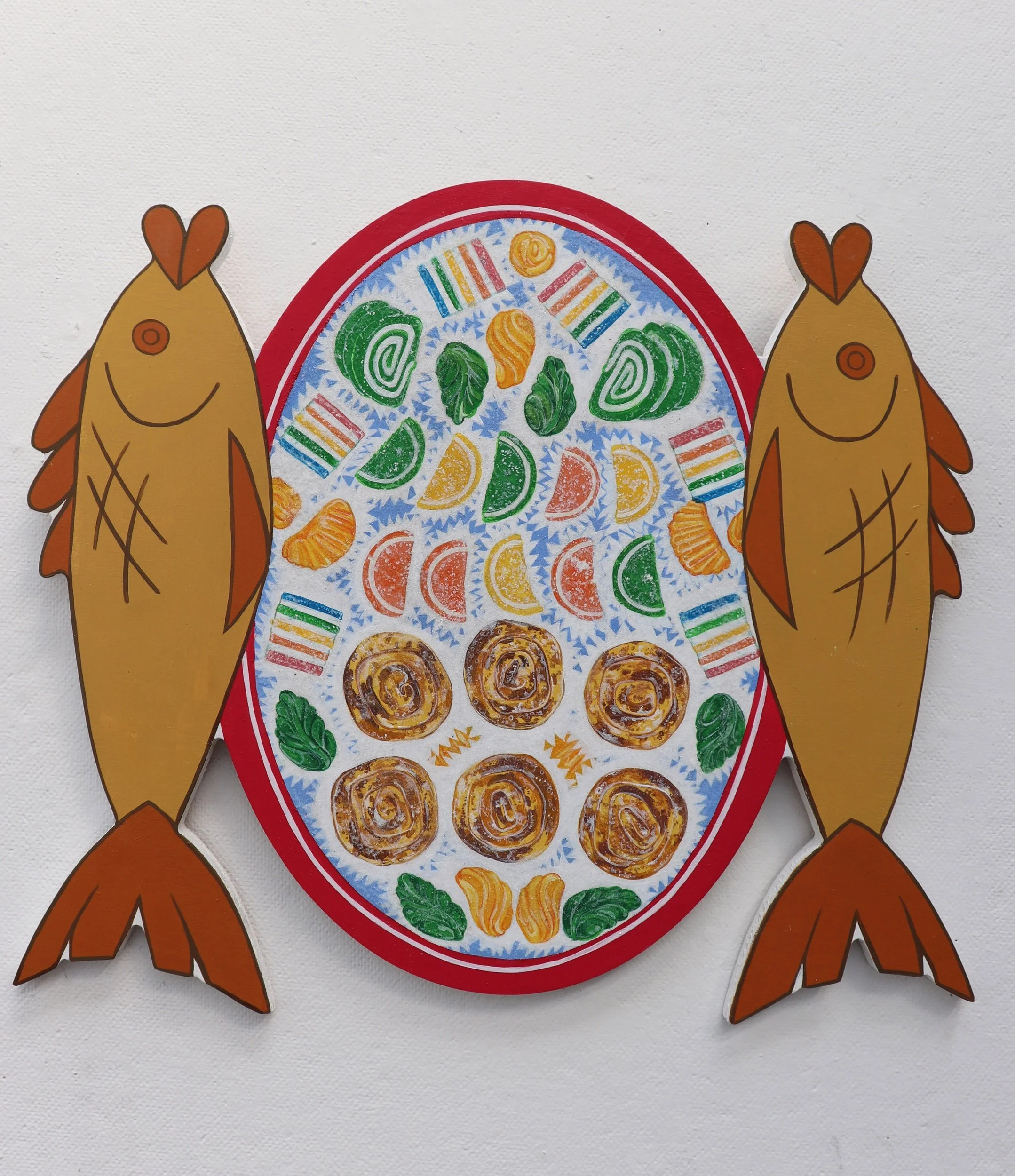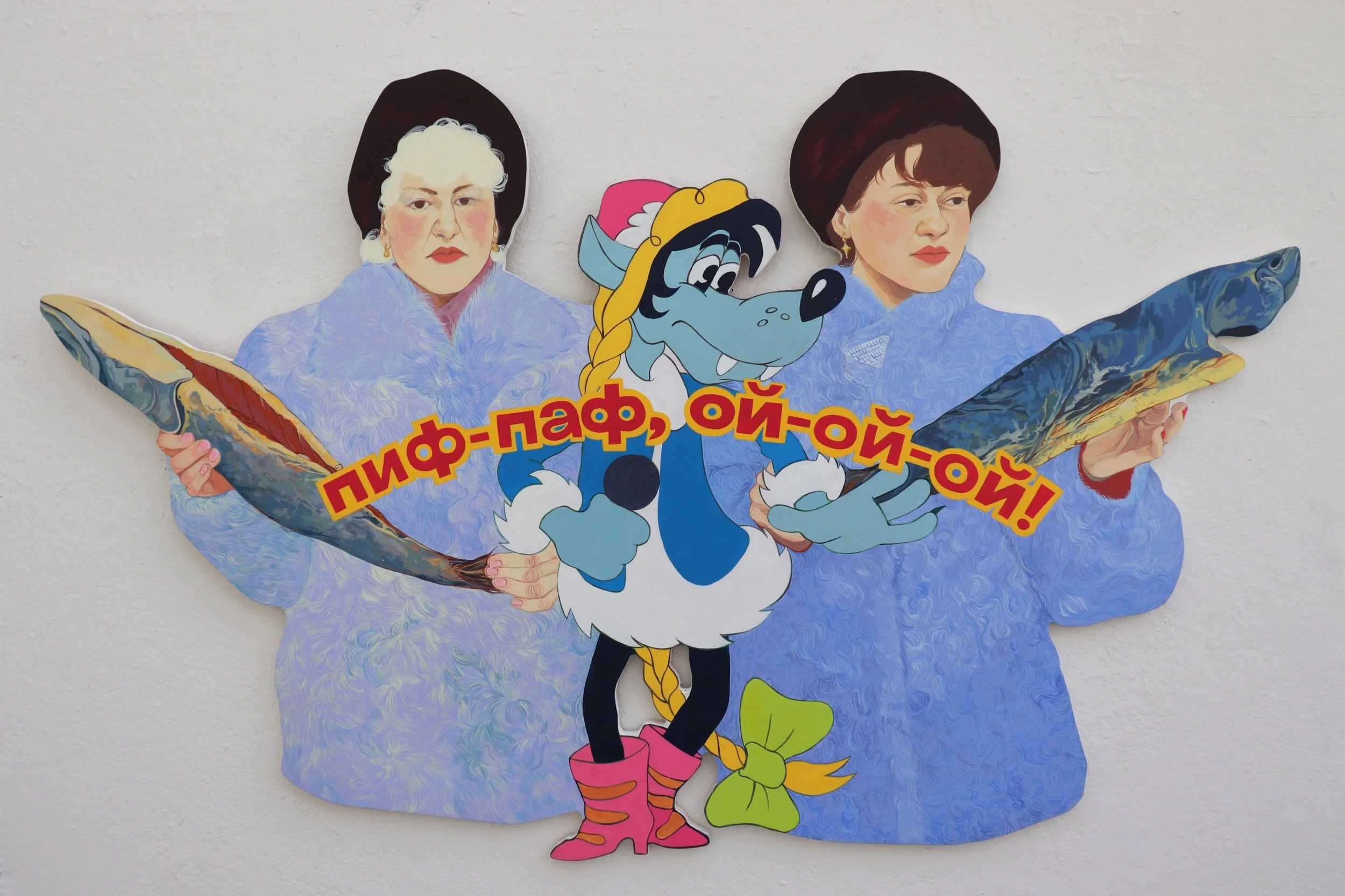On the Post-Soviet Subject: Pittsburgh-based Artist Ester Petukhova featured in Tchotchke Gallery’s Group Exhibition.
The exhibition is online and can be viewed here: https://tchotchkegallery.com/baroque
Housed in the virtual space of Tchotchke Gallery’s group show If It’s Not Baroque, Don’t Fix It, sit two of Ester Petukhova’s acrylic-on-panel works, Militant Mink (2022) and Five Loaves, Two Fish, and a Box of Marmalades (2022). Both investigate themes of image circulation, post-Soviet subjectivity, and the potential, as well as the shortcomings, of a historically complicated archive. In these works, both the amicability and clashing of images point to a larger question surrounding the autonomy of the image, as well as the autonomy of those whose bodies are visually captured.
In Militant Mink, several threads of discursive inquiry find their meeting point of entanglement. Plucked deep from the chasms of Soviet-era photographic archives, the figures of two women donning powder-blue mink coats frame the body of a third, less detailed subject—a cartoon. These women, pink-lipped and armed with fishes, are positioned defensively with faces of both displeasure and indifference, gazing either towards us or a distraction beyond the frame. Protected by the safety of feminine association, an animated wolf, dressed in drag with his braided blonde wig and matching pink boots and hat, performs the role of Russian fairy tale character Snegurochka (or the Snow Princess). The source from which the wolf is cited is that of the Soviet series of animated short films titled “Ну, погоди!,” or “Well, Just you Wait!” Wolf’s name translates to Волк, and he, along with Заяц (or the “Hare”), went on to costar in one of the most beloved Russian cartoons of all time. The specific scene from which Волк is reproduced is one from an episode centered around the Eastern Orthodox Christmas holiday, where Волк and Заяц dress up and perform a karaoke duo.
The second work Five Loaves, Two Fish, and a Box of Marmalades takes the form of an oval container of Russian marmalades and sugary gelatinous rolls, sandwiched by orange cartoon fish on either side. The fish reference yet another “Ну, погоди!” short film, one in which Волк is tricked by Заяц into biting a metal-cast orange fish out of hunger. Волк then subsequently destroys his furniture and home television set out of anger as Заяц’s image is broadcasted through the device, taunting and ridiculing his gullibility. These references, these fish, can thus be traced back to a series of moments of malicious deception that catalyzed the destruction of all one has—or in this case, all the wolf had. The destruction of the television set, however, prompts a more nuanced and interesting conversation, one that finds its principal concern in the ruinous potential of circulated images.
What Militant Mink and Five Loaves make worth exploring is the visual economy of Soviet bodies, and the mass circulation of images of the era. Petukhova anchors her usage of figurative realism as a practice rooted in both care and sociopolitical inquiry, citing “bodies in the Soviet Union, and how they are granted autonomy” as one of the main investigative axes of both these works, as well as her practice overall. These figurative renderings of Soviet-era bodies, such as in Militant Mink, following archival extraction behave as reconsiderations of how subjectivity can be re-introduced following the damage inflicted upon the corporeal by mass circulation. The images of Soviet corporeality have often traveled outside the boundaries of their designated parameters, often being lost within the realms of Facebook, Twitter, Vine, Instagram, Tik Tok, etc., and falling victim to projection, recontextualization, and memetics. What seeing these forces in action shows us in our contemporary moment is that images that circulate far from their visual economies of origin increasingly lose their subjectivity; their dimensions of humanity begin to faulter during this process, just until we are left with the skeleton of a subject’s image.
The abstraction of post-Soviet subjectivity as a consequence of mass circulation has produced a metaphysical stand-in for flesh and bones, an entity that has lost itself to manipulation by regimes of power (particularly within a western digital landscape). A primary example of this is what Petukhova describes as “the abstracted presence of a figure looming just behind the cybernetic landscape,” or in other words, the headless Russian cyberwar criminal that exists somewhere beyond the line of sight, waiting and handwringing. Observing this stand-in for millions of bodies prompts the most important question of all: who is the post-Soviet Russian? Petukhova’s panels offer themselves as investigative texts that attempt to grapple with this very concern. Through archival citations of the Soviet body, as well as the recontextualization of iconic cultural film, Militant Mink and Five Loaves ask us to reassess how we design the post-Soviet Russian in all their nuance and subtleties.
Mara Hassan is a curator and PhD student at Stanford University.


